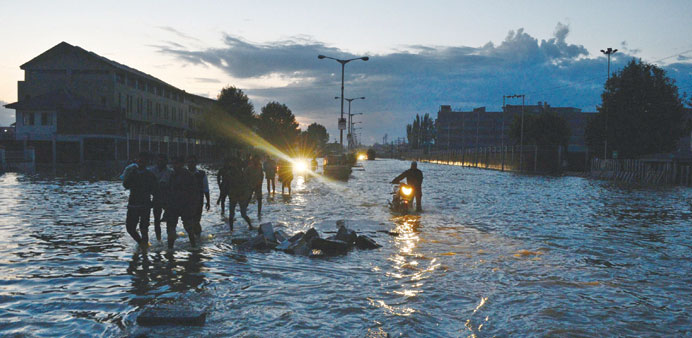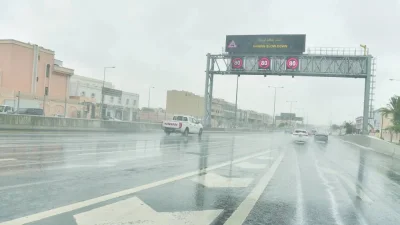People wade through floodwaters in Srinagar yesterday. Fresh rain hampered rescue operations in Kashmir, a week after deadly floods swamped the state.
Agencies/Srinagar
Fresh rain hampered rescue operations in Jammu and Kashmir yesterday a week after deadly floods swamped the state, with medics and survivors describing nightmarish conditions in the devastated city of Srinagar.
The floods and landslides have now claimed at least 220 lives in Kashmir, and rescuers are struggling to cope with the scale of the disaster.
After a few clear days, more rainfall accompanied by thunder and lightning hit relief operations in the worst affected areas of Srinagar, the normally scenic city in Kashmir.
Chief Minister Omar Abdullah, who has come under fire over the slow pace of the rescue effort, admitted his government was “completely paralysed” in its immediate response to the disaster.
“We had no way to communicate with anyone, and other than a walkie talkie set...we were totally and completely isolated from everyone and everywhere,” Abdullah wrote in a first-person account published in the Indian Express newspaper yesterday.
About 150,000 people are still stranded in their homes.
Army and civilian boats trawled through the streets - now water channels - of Srinagar picking up residents and delivering water, food and basic medicine to people who chose to remain camped out in the upper floors of their houses.
While nine stranded patients at Kashmir’s biggest maternity care facility Lal Ded Hospital were finally evacuated on Friday, some relatives continued to wade through chest-deep water to look for family members who had been admitted before floods struck.
One woman, who gave birth in the hospital, said of her rescue from the swirling floodwaters in the hospital.
“We took refuge inside a mosque for three days after some local young men rescued us from the hospital,” she said, without giving a name.
“We are in the middle of a sea without any help.”
Doctors at the state-run Bone and Joint Hospital in Srinagar scrambled to treat casualties after medical supplies were carried off by the waters.
“We need medicines of all kinds, it is a disaster,” a doctor, speaking anonymously, said while examining a patient. “Tonnes of medicines were just washed away.”
Medics are having to work round the clock to help treat patients who have sustained fractures, with submerged potholes a particular danger.
“I made 20 casts today,” hospital worker Ghulan Hassan said as he tried to prepare the casts in a room whose floor had caved in.
The new rainfall magnified the stench of death from animal carcasses, rotting vegetables and overflowing drains.
“It makes your eyes burn, gives you a headache,” Mehraj-Ud-Din Shah, chief of State Disaster Response Force, said.
Officials said it was too early to assess the full extent of the disaster with many roads still impassable but Abdullah wrote that the recovery effort was “going to be a long, hard, and very steep climb.”
O P Singh, director general of the National Disaster Response Force, said the big worry now was of the spread of water-borne diseases.
“Many parts are still submerged in 4-5ft of water and we are concentrating on supplying anti-diarrhoea, anti-infection medicines and using chlorine to avert diseases,” he said in Srinagar.
“We have had to halt our operations for some time and we are waiting for the weather to clear,” Indian Air Force spokesman Gerard Galway said.
The disaster has fuelled public anger in the state where a revolt against Indian rule has simmered for nearly a quarter century.
A new generation of young Kashmiris, who have grown up with house raids and army checkpoints, feel increasingly angry at Indian rule and champion street protests rather than the violent militancy that characterised the 1990s.
Jammu and Kashmir Revenue Secretary Vinod Kaul said it was natural for citizens to blame their government when struck by a disaster of this scale. “This is a democratic system,” he said.



